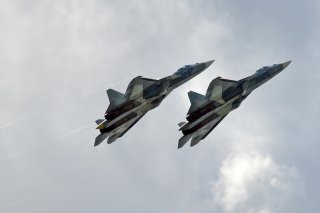Can Russia’s Air Force Tough It Out Against NATO’s Stealth Fighters?
The Russians themselves don't seem that confident.
Here's What You Need To Remember: The Russian Air Force has ordered a dozen Su-57s, enough to form a squadron that will become operational in 2019. Russia has touted videos of the twin-engined, Mach 2 Su-57 flying a couple of combat missions in Syria, or performing aerobatic maneuvers. But that’s a far cry from mass production of an aircraft that was supposed to replace Cold War Su-27 and MiG-29 fighters, and take on American F-22 and F-35 stealth jets.
Russian airpower is inferior to U.S. airpower, according to one Russian news site.
But is this genuine fear, or a marketing ploy to goad the Russian government into buying a stealth fighter that it doesn’t really want?
The article appeared on Vzglyad [Google English translation here], a Web news site founded by a Russian tech entrepreneur who reportedly taught the Russian government how to troll on social media. But the piece was hardly complimentary to the government’s defense policy.
In particular, it took aim at Russian boasts that its Su-57 stealth fighter is better than the U.S. F-22 and F-35. To which writer Mikhail Bolshakov offered a practical rejoinder: America is flying hundreds of F-22s and F-35s, while Russia has canceled mass production of the Su-57.
“By the end of 2018, Russia does not yet have a serial [production] Su-57, while the United States has already released 187 serial F-22s and more than 320 serial F-35s,” Bolshakov writes. “In other words, even if we take for granted the assertions that Russian fighters are better than American ones, the United States has at least these fighters in service. And Russia does not.”
The Russian Air Force has ordered a dozen Su-57s, enough to form a squadron that will become operational in 2019. Russia has touted videos of the twin-engined, Mach 2 Su-57 flying a couple of combat missions in Syria, or performing aerobatic maneuvers. But that’s a far cry from mass production of an aircraft that was supposed to replace Cold War Su-27 and MiG-29 fighters, and take on American F-22 and F-35 stealth jets.
Interestingly, the Vzyglad article doesn’t dispute the assertion that the Su-57 is better than its American stealth counterparts. What it does criticize is the small numbers of fourth-generation (late Cold War) Russian aircraft such as the Su-30 and Su-35.
“As of the beginning of 2018, only 194 Su-30 units of various modifications and 70 Su-35 units are in the Russian Air Force. In addition, it is unknown how many of these machines are really combat ready. Therefore, in general, taking into account the fourth-generation fleet of vehicles, the Russian Air Force is significantly inferior to the United States Air Force and, all the more, the combined aviation power of the NATO countries.”
New aircraft trickle in with two or three planes at a time, which “creates a headache with regard to the training of pilots, as well as the maintenance, supply and repair of the aircraft themselves,” Bolshakov warns. “The simultaneous performance of two conflicting tasks — and retraining the pilots to new planes, and performing current combat missions on old ones — makes a mess and confusion in the front-line fighter regiments. In addition, the units often do not know when they will receive at least these rare new machines, and can not plan the appropriate personnel movements.”
This also results in air regiments equipped with multiple models of aircraft, and multiple variants of each model, which creates even more logistical and operational problems.
Bolshakov blames the situation on Russia’s weak finances. After the collapse of the Soviet Union, Russia in the 1980s and 1990s focused on improving its fourth-generation Cold War aircraft instead of fifth-generation models like the Su-57. While several hundred advanced fighters were produced, many were exported to foreign customers for cash instead of the Russian air force.
Bolshakov suggests the solution is to order larger quantities of jets, and indulges in a bit of numerology by pointing out that mathematically, (F) 22 + (F) 35 = (Su) 57. But in this case, the numbers that matter belong to the accountants. Russian officials say that serial production of the Su-57 isn’t needed yet because fourth-generation fighters are still capable, while Western observers point to the Russian aerospace industry’s perennial problem with producing reliable jet engines. But the fact remains that the Su-57 costs at least $40 million apiece, less than half the price of an F-35, but too much for an economy that’s less than one-tenth the size of America’s.
Michael Peck is a contributing writer for the National Interest. He can be found on Twitter and Facebook. This first appeared in August 2019.

